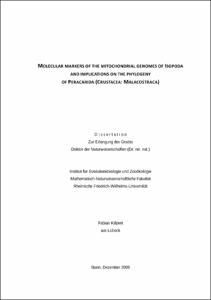Kilpert, Fabian: Molecular markers of the mitochondrial genomes of Isopoda and implications on the phylogeny of Peracarida (Crustacea: Malacostraca). - Bonn, 2010. - Dissertation, Rheinische Friedrich-Wilhelms-Universität Bonn.
Online-Ausgabe in bonndoc: https://nbn-resolving.org/urn:nbn:de:hbz:5N-21168
Online-Ausgabe in bonndoc: https://nbn-resolving.org/urn:nbn:de:hbz:5N-21168
@phdthesis{handle:20.500.11811/4570,
urn: https://nbn-resolving.org/urn:nbn:de:hbz:5N-21168,
author = {{Fabian Kilpert}},
title = {Molecular markers of the mitochondrial genomes of Isopoda and implications on the phylogeny of Peracarida (Crustacea: Malacostraca)},
school = {Rheinische Friedrich-Wilhelms-Universität Bonn},
year = 2010,
month = apr,
note = {The mitochondrial genome features structural and organizational characters, also referred to as characters of ‘genome morphology’, in addition to primary sequence data. This thesis analyzes the state, evolution, and phylogenetic value of these characters in peracarid crustaceans, with the focus on Isopoda and putative isopod sister group taxa (Amphipoda, Cumacea). Therefore, eight complete or almost complete isopod mt genomes were sequenced, as well as an entire amphipod mt genome and about half of a cumacean mt genome. The comparison revealed several significant changes of character states of the mtDNA (mitochondrial gene order, nucleotide strand bias, tRNA secondary structure etc.). These characters were mapped on a molecular tree of isopods to trace the sequence of changes and to evaluate their phylogenetic significance. It is striking that gene arrangements differ in all examined mt genomes. However, several derived gene positions are shared among isopods, which even allow inferences on the gene order of the isopod ancestor (isopod ground pattern). There are also indications that the Cumacea share main rearrangements with isopods. This is not the case for the Amphipoda, which therefore do not qualify as the isopod sister group. Although there are also indices on rare homoplasious translocation events of tRNA genes in isopods, gene order changes can be overall evaluated as phylogenetically informative characters. This applies particularly to complex rearrangements comprising protein-coding and rRNA genes, which are unlikely to emerge by convergent evolution. The overall frequency of rearrangements appears to be higher in the examined species than usually assumed for mt genomes, but is still far from saturation. The diversity in gene order should be also valuable for inferring phylogenetic relationships of closer related isopod or peracarid species. In some cases it is even possible to infer the mechanism of a translocation event, e.g. inversion by intramolecular recombination or translocation by remolding of tRNA genes. Another rare and complex character, a bias in the nucleotide composition of DNA strands, is shared by the Asellota and most other crustaceans, but is reversed in the majority of Isopoda. This finding is contrary to the position of the Phreatoicidea being the sister group to all other isopods e.g. proposed by the sequence analysis.},
url = {https://hdl.handle.net/20.500.11811/4570}
}
urn: https://nbn-resolving.org/urn:nbn:de:hbz:5N-21168,
author = {{Fabian Kilpert}},
title = {Molecular markers of the mitochondrial genomes of Isopoda and implications on the phylogeny of Peracarida (Crustacea: Malacostraca)},
school = {Rheinische Friedrich-Wilhelms-Universität Bonn},
year = 2010,
month = apr,
note = {The mitochondrial genome features structural and organizational characters, also referred to as characters of ‘genome morphology’, in addition to primary sequence data. This thesis analyzes the state, evolution, and phylogenetic value of these characters in peracarid crustaceans, with the focus on Isopoda and putative isopod sister group taxa (Amphipoda, Cumacea). Therefore, eight complete or almost complete isopod mt genomes were sequenced, as well as an entire amphipod mt genome and about half of a cumacean mt genome. The comparison revealed several significant changes of character states of the mtDNA (mitochondrial gene order, nucleotide strand bias, tRNA secondary structure etc.). These characters were mapped on a molecular tree of isopods to trace the sequence of changes and to evaluate their phylogenetic significance. It is striking that gene arrangements differ in all examined mt genomes. However, several derived gene positions are shared among isopods, which even allow inferences on the gene order of the isopod ancestor (isopod ground pattern). There are also indications that the Cumacea share main rearrangements with isopods. This is not the case for the Amphipoda, which therefore do not qualify as the isopod sister group. Although there are also indices on rare homoplasious translocation events of tRNA genes in isopods, gene order changes can be overall evaluated as phylogenetically informative characters. This applies particularly to complex rearrangements comprising protein-coding and rRNA genes, which are unlikely to emerge by convergent evolution. The overall frequency of rearrangements appears to be higher in the examined species than usually assumed for mt genomes, but is still far from saturation. The diversity in gene order should be also valuable for inferring phylogenetic relationships of closer related isopod or peracarid species. In some cases it is even possible to infer the mechanism of a translocation event, e.g. inversion by intramolecular recombination or translocation by remolding of tRNA genes. Another rare and complex character, a bias in the nucleotide composition of DNA strands, is shared by the Asellota and most other crustaceans, but is reversed in the majority of Isopoda. This finding is contrary to the position of the Phreatoicidea being the sister group to all other isopods e.g. proposed by the sequence analysis.},
url = {https://hdl.handle.net/20.500.11811/4570}
}






